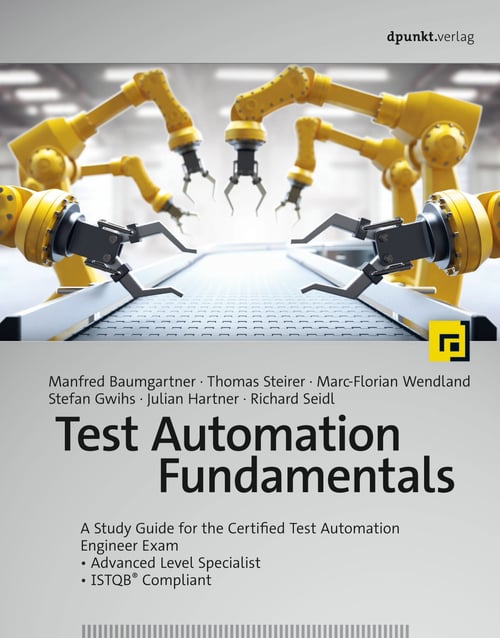Test Automation Fundamentals – A Study Guide for the Certified Test Automation Engineer Exam has recently been released in the market. This book provides a complete overview on designing test automation processes and integrating them into your organization or existing projects. After its originally published German edition in 2011, we can finally hold the detailed English version in our hands. My co-authors and I couldn't be prouder. In this article, I would like to give you a behind-the-scenes look about this bestseller and about test automation itself.
Who doesn't long for certainty and more ease in everyday life? Which company does not have increased efficiency and faster time-to-market as part of its goals? These longings especially apply to all people and companies dealing with software development, or whose working environment is shaped and influenced by software-controlled systems on a massive scale.
As a representative of a special species among software engineers called software testers, I have always found myself saddled with tension in the following aspects:
- The pressure for rapid delivery after delayed development completion.
- The selection of a manageable test set versus an almost infinite number of test cases and increasingly limited time frames.
- The knowledge of software changes but often not of their complex and inscrutable effects on the system behavior
- and the fact that even when testing to the best of my knowledge, bugs will make it into production and inevitably the question will come up "Why wasn't that tested?"
To make life a little easier for myself, and to ensure some free time for creative testing activities, I started looking deeper into the topic of test automation from an early stage. Now, I do realize that not all problems can be solved through test automation, and not all areas of tension can be eliminated. On the contrary, at times, even more problems can get added. But in many of these aspects, test automation gives us a tool to achieve significant progress as a software tester and thus, in software engineering.
Benefits of Test Automation
Based on my 20+ years of experience in test automation, the biggest benefits for me are:
- More thorough testing: By establishing and expanding a comprehensive automated regression test set, the potential negative effects of software enhancements and changes can be identified with a much higher probability than through manual testing.
- Reduced manual effort: Manually performed regression test can be reduced to a minimum, which pleases everyone who had to perform this so far, and which creates freedom to test creatively in those corners where the automated test cannot reach - keyword intuition.
- Massive speedup: Automated testing provides rapid feedback to development: Instead of days, the same task can now be completed in a few hours, which is often crucial.
- Tests at scale: Apart from automated regression testing, the tester is now able to execute specific test scenarios that were otherwise not feasible, or only feasible at great expense - and even if so, only once. Take, for example, extensive combinatorial limit tests of different contract conditions, supported by automatic test data generation. In just a few steps, you can do what you would otherwise have taken many hours and days to accomplish.
- Transparency: I also consider the traceability and plannability of the automated tests to be relevant for test management. This also makes it easy to create transparency about time, effort, test coverage and test results.
- Enormous future potential: In future, the use of artificial intelligence (AI) and machine learning (ML) will bring even more undreamed-of potential to light.
Challenges in Test Automation
Like in life, likewise in testing. You don't get all only the benefits of any choice. Everything also has its flip side. Similarly, the use of test automation also entails its share of challenges:
- Test automation is software development: Test automation is also subject to the laws of software development. It can be done well or badly. It can either be designed and implemented in a sustainable way or it can perish after some time because of high maintenance efforts and lack of transparency. It can work for some time as a hobby of a test automation freak or it can represent an essential factor for efficiency and stability as part of the corporate philosophy.
- Automation does not replace manual testers: It is a serious mistake to regard test automation as any replacement of analytical-methodical testing by test engineers. Garbage in - garbage out - the test automats still function according to this principle.
Why should you have a copy of the book?
Anyone who wants to work on the topic of test automation in the future would do well to take a serious and professional look at this technology.In 2016, the International Software Testing Qualifications Board published the syllabus for training and certification as an ISTQB® Certified Tester - Test Automation Engineer, which has been successfully offered and accepted in the market for many years.
My co-authors (three of them are also from Nagarro) have enriched this content with the topics of our book "Basiswissen Testautomatisierung" (German, 2011 | 2015 | 2021). Thus, besides our full-time jobs in quality projects, we created an insightful piece of content: "Test Automation Fundamentals: A Study Guide for the Certified Test Automation Engineer Exam - Advanced Level Specialist - ISTQB® Compliant", which was published at the end of September 2022.
The key topic here is the definition of the test automation architecture and its implementation in the company and in its projects.
The book covers:- An introduction to test automation
- Objectives and success factors
- Preparing for test automation
- Generic test automation architectures
- Automation solution design and development
- Deployment risks and contingencies
- Metrics and reporting
- Transitioning from manual to automated testing
- Verifying a test automation solution
- Continuous improvement
%20(1).png?width=500&name=MicrosoftTeams-image%20(21)%20(1).png)
Test automation architecture and its implementation
The appendix contains an overview of software quality characteristics, according to the ISO 25010 standard, and lists potential test automation applications within this context. It also introduces readers to load and performance testing, and a sample catalog of the criteria for selecting test automation tools.
This book prepares its readers very well for the challenges that await them as test automation engineers. By the way, the book can also be very helpful for the ISTQB Certified Tester AL TAE exam. However, the goal is not certification, but to make our work more effective and efficient and to achieve our objectives with more ease.
Many thanks to my co-authors, our publishers dpunkt.verlag and Rocky Nook, the editors and copyediting, and to Nagarro for making this project possible for us.
I hope you enjoy the book. Happy reading!

Test Automation Fundamentals
A Study Guide for the Certified Test Automation Engineer Exam
Product Information UK & Europe
- Publisher: dpunkt.verlag GmbH; 1. Edition (1. September 2022)
- Language: English
- Paperback: 330 Pages
- ISBN-10: 3864909317
- ISBN-13: 978-3864909313
Get your copy: Test Automation Fundamentals
Product Information US & all other territories
- Publisher: Rocky Nook (11. October 2022)
- Language: English
- Paperback: 330 Pages
- ISBN-10: 1681989816
- ISBN-13: 978-1681989815
Get your copy: Test Automation Fundamentals



.png)
.png)
